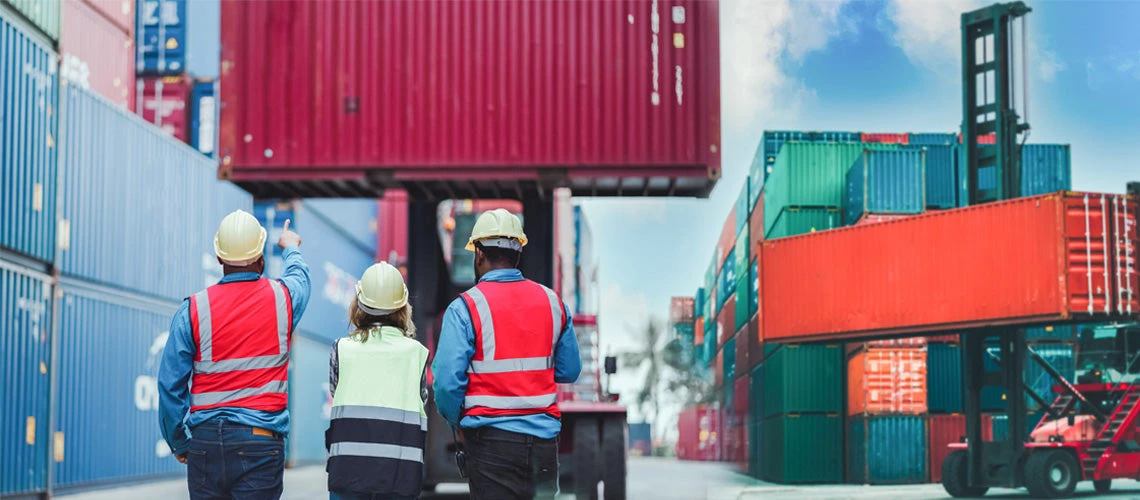 Industrial worker works with co-worker at overseas shipping container yard. Logistics supply chain management and international goods import and export concept
Industrial worker works with co-worker at overseas shipping container yard. Logistics supply chain management and international goods import and export concept
After decades of accelerating globalization, since 2008 international trade has grown at roughly the same pace as economic activity in developing economies. While a trade slowdown is not deglobalization, these developments should be watched with some trepidation. Over the decades of accelerating global integration, international trade proved to be a remarkable engine of prosperity. In developing countries that embraced globalization, it drove per capita income growth and poverty reduction.
However, growing geopolitical tensions, concerns about economic security, and supply chain resilience have prompted some countries to de-risk by changing their supply chain. On top of this, we have seen a proliferation of trade barriers and subsidies aimed at addressing the distributional impacts of trade domestically and supporting the green transition globally. While these are legitimate concerns, we must avoid unintended consequences of these approaches, particularly in developing economies.
Three proposals to reinvigorate international trade in turbulent times are discussed here. Before getting into the specifics, some more context is warranted.
We are experiencing the weakest expansion in the trade of goods and services compared to any global recovery in the last five decades. Though global trade volumes are above 2019 levels, global trade in goods in 2023 decreased compared to 2022. Moreover, in the context of weak trade and investment, high interest rates, high debt levels and ballooning debt service payments, growth is expected to be slow for the third year in a row in 2024 in developing economies.
If anything, trade by developing countries has lagged behind that of advanced economies and that of their own economic activity. These are worrying trends. A forthcoming report by the World Bank shows that until the global financial crisis, exports contributed to job creation and income growth in developing countries, and especially in middle-income countries. Participating in international markets also increased the share of salaried jobs relative to self-employment, promoting employment formalization.
Beyond macroeconomics, the slowdown of international trade and the reconfiguration of trade patterns owes much to policy choices. The number of export bans and other measures restricting trade has quadrupled since 2020. Trade is increasingly conducted with countries that are geopolitically closer to each other through the process of “near-shoring.”
These measures reduce global economic efficiency. A growing reliance on trade restrictions at the beginning of the war in Ukraine, including bans on the exports of key staples and agricultural inputs, increased food prices and their volatility, worsening food insecurity.
Proliferating subsidies can distort trade even more than tariffs. Today, almost half of traded goods are covered by a subsidy, up from 20 percent in 2012. This is clearly shown by the estimated tariff equivalent of these burgeoning subsidies, which has reached 15 percent on average for agriculture and 8 percent for manufacturing. On climate change, with uneven mitigation policies and wide disparities in compliance across countries, there is a reasonable concern that trade could shift global production to less environmentally-friendly places. Sustainability standards for imports have proliferated to address these risks, as well as carbon border adjustment mechanisms to prevent domestic producers from unfair competition from countries with lower environmental standards.
However, well-intended policies may have serious unintended consequences for developing countries. Sustainability standards whose enforcement is costly may disproportionally penalize countries with weak institutional capacity. The same is true of carbon tax adjustments at the border, which could unfairly impact small- and medium-sized enterprises and agricultural producers from developing countries.
The combination and deepening of all these measures could have a significant effect on international trade and, beyond it, on economic activity. A review of available estimates suggests that the associated long-term losses could be in the range of 1 to 7 percent of global gross domestic product. We need a better balance between commendable goals and practical consequences. To do this, we must have a coordinated set of strategic actions to support developing countries and find a balanced path for their transition.
As part of this, three actions stand out.
First, at the global level we must restore the basic functions of a rules-based trading system. Ensuring a level playing field and offering credible dispute resolution mechanisms are global public goods.
Second, at the regional level bilateral or plurilateral trade agreements can help ensure access to markets, reduce transaction costs, and increase transparency. A new generation of such agreements is of particular interest because they also focus on key behind-the-border issues that matter for trade. These deeper agreements have focused on fair competition in domestic markets, a level playing field for state-owned enterprises, and even labor and environmental standards. However, a deliberate effort should be made to ensure that these regional trade agreements—especially the deeper ones—are “interoperable” in the sense of relying on highly similar principles and operational criteria.
Third, developing countries should each strive to further integrate into the global economy, despite the current geopolitical tensions and protectionist pressures. One area in which there has been no slowdown in recent years is digital services. While global goods trade growth in developing economies declined, their sales of online services have grown by 250 percent between 2005 and 2022. Digitally provided services hold great employment potential for women, youth, and other disadvantaged groups. But becoming a digital exporter is challenging when a significant share of the population has no access to the internet, not to mention access to electricity. Promoting digitization and enhancing connectivity to the grid should thus be part of the global integration agenda.
All these concerns and options for viable solutions will be discussed at the 13th Ministerial Conference on Trade in the next days.



Join the Conversation